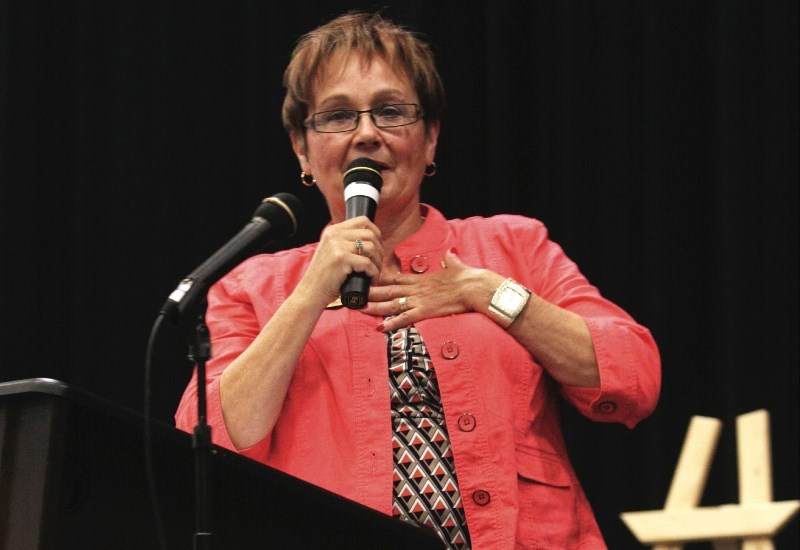With personal income taxes due for many Alberta residents at the end of the month, there's no doubt that it's on the minds of many that this will be the last year filing under the current tax bracket system.
As of Jan.1, 2016 the new personal income tax brackets will be introduced for filing 2015 income taxes. The changes came with the announcement of the 2015 budget and aim at bringing in more revenue from higher earners in the province.
Phased in over three years, residents earning over $100,000 per year will see their taxes increase to 11.5 percent. Earners over $250,000 will see their tax rate increase to 12 percent by 2018. Albertans whose income is under $100,000 will be unaffected by the changes, keeping at a 10 percent tax rate.
Outgoing Bonnyville – Cold Lake MLA Genia Leskiw said she believes the provincial government made the right decision.
“The government is still protecting the vulnerable and low income person, which is the people we should be helping. If you have more, you should be able to contribute more to our province and our community.”
This is the first tax increase Alberta has had since 1987. The changes outlined are expected to generate an additional $330 million in revenue in 2016 to 2017. By 2018/19 there is expected to be $730 million in the provincial coffers as a direct result of the new personal income tax brackets.
“In 2014, if Alberta had employed the tax system of any other province, Albertans and Alberta businesses would have paid at least $11.6 billion more in taxes,” said Finance Minister Robin Campbell, in his 2015 budget speech.
He added, “This means Alberta has flexibility to place revenues on more stable footing, while remaining the most tax-competitive place in the country.”
Compared to other provinces in Canada, Alberta's tax rates for the highest earners in the province are still far less. However, for the lower income earners, Alberta's 10 percent rate is substantially higher than other provinces.
In Ontario for example, there are five different tax brackets ranging from 5.05 percent on taxable incomes up to $40,922 to 13.16 percent for incomes over $220,000. The province of British Columbia has six personal income tax brackets, which range from 5.06 percent for incomes up to $37,869 to 16.8 percent for incomes over $151,050.
Also being administered through the personal income tax system is the new health care contribution levy. With health care being one of the biggest costs in the provincial budget, Leskiw said it is sometimes forgotten that the money for the health care system has to come from somewhere.
“Once they stopped handing out the forms that said what you as an individual cost the government in health care people sore of take it for granted that health care is free,” said Leskiw.
She added, “If you're making over $50,000 you're contributing a little bit and it's still a lot less than if you had to pay out of pocket like they do in the United States.”
The annual health care levy payment begins at a maximum of $200 for incomes between $50,000 and $70,000. The levy rate then increases by $200 for every $20,000 additional income, maxing out at $1,000 for incomes of $130,000 and over.
The health levy is expected to raise $369 million in 2015-16, rising to around $530 million in 2016-'17. This revenue collected will be transferred into ‘general revenue' and will contribute to health care costs in the province.
One area that will be completely unaffected by the budget is corporate taxes. Campbell noted in his budget speech that 95 percent of all businesses in the province are small businesses.
“Our small community isn't run by big corporations, it's run by community people who have built this town. According to economists, they say for every one percent raise in corporate taxes you lose a lot of jobs,” explained Leskiw, who also noted that businesses would need to recover the extra costs, which could potentially lead to charging the customer more.
The 2015 budget tax changes aimed at protecting businesses and low-income earners, particularly families. With that came the introduction of a new refundable tax credit – the Alberta Working Family Supplement (AWFS). Starting July 1, 2016, this new program is designed to benefit families earning under $41,250 and will provide an additional $85 million in direct support to around 75,000 Alberta families.
Under the new AWFS families can earn up to $25,000 before benefits begin to phase-out. The benefit amounts range from $1,100 for the first child to $2,750 for four or more children.
The province also added enhancements to the Alberta Family Employment Tax Credit (AFETC), which is already adjusted annually to offset the impact of inflation. Starting July 1, 2016, the rate at which benefits are phased in will increase from eight percent to 11 percent on working incomes over $2,760.
Under the enhanced AFETC, as of this year's rates, families would earn $754 for the first child and up to $1,987 for four or more children. The amount which families can earn before benefits start to be phased-out will also increase from $37,778 to $41,250.
“This change will provide an additional $25 million in benefits for lower and middle-income families,” said Campbell.
Overall, Leskiw said the changes to Alberta's tax system that came through with the 2015 budget ensured that those who could afford to pay more do and safeguards those who can't.
“That's what the government's about, it's about protecting those that need the help…I think it's important that the people in low income or vulnerable are protected.”



